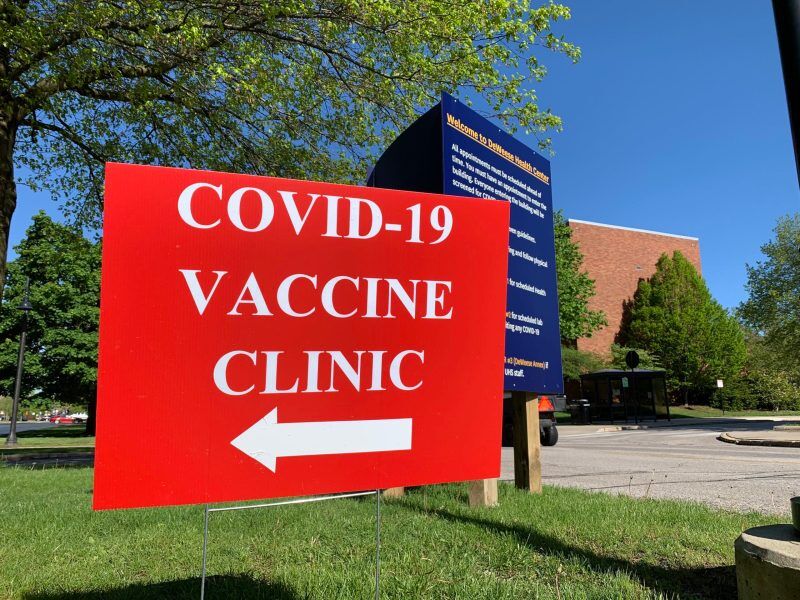Vaccine distribution slows in Ohio, health officials holding out for herd immunity
Sign advertising a COVID-19 vaccine clinic at the DeWeese Health Center on Kent State’s campus. May 10th 2021 (Rachel Gross)
June 3, 2021
The Franklin County Health Department is receiving more vaccines a week than they can give out.
“We’re having to kind of change our strategy a bit,” said Alex Jones, the assistant Health Commissioner of Franklin County, Ohio. “[We have to] meet folks where they are.”
Jones said Franklin County offers many different access points for residents looking to be vaccinated, from large-scale operations done by the FCDH, to smaller ventures done by local EMS partners.
Eight fire EMS partners in the county have been approved by the state to provide vaccines and they mobilize to groups that may have difficulty getting out to a mass vaccination site. This includes low-income senior housing, residential behavioral health centers and homebound clients.
“We don’t want there to be any barriers to being vaccinated,” Jones said.
In Franklin County, where Columbus is partially located, 42% of residents have been fully vaccinated according to the Ohio Department of Health as of June 1st, 2021.
Another 48% have received at least one dose.
“We’re on par with the Ohio counties that are similar in size and makeup to ours,” Jones said.
Similar counties to Franklin include Cuyahoga and Hamilton counties, in which Cleveland and Cincinnati are located respectively.
Forty four percent of Cuyahoga County residents, and 42% of Hamilton County residents have been fully vaccinated. However, the number of people looking for a vaccine in Ohio has dropped.
“We are seeing a slowdown,” Jones said. “Not just us here in Franklin County, but [counties] across the state are seeing the slowdown.”
Jones said the statewide slowdown in vaccinations could be attributed to people who are on the fence about the vaccine.
In Portage County, health officials are not sure if everyone who is eligible will take the opportunity to get the vaccine.
“There is hesitancy across the board for all types of vaccine[s],” said Joan Seidel, the Kent City Health Commissioner. “So, I am not surprised at all [that some are] holding a concern for receiving [the] COVID vaccine.”
The city of Kent has been utilizing Portage County Health Department mass vaccination clinics to get residents vaccinated.
Clinics have been held at Kent State University Field House, the Deweese Health Center, and even the PARTA bus garage.
Seidel said there has been good turnout at these clinics, but she is still uncertain if all residents will take the vaccine.
“I know there are many who are very against it, and some who are just unsure,” she said.
Vaccine distribution in Ohio has gone well, but Seidel said she hopes in the months to come that the state will improve access and distribution, which will increase vaccination numbers.
In the state of Ohio, 40% of residents have been fully vaccinated according to the Centers for Disease Control and Prevention as of June 1, 2021.
Another 45% have received at least one dose.
But the state still has ways to go before herd immunity can be reached.
“I believe 70% is usually that number that they kind of throw out there [for herd immunity],” Jones said. “Either 70% of people who have had the disease or 70% who have been vaccinated.”
States like Connecticut and Maine have approximately 54% of their residents fully vaccinated, which is close to what is needed for these states to reach herd immunity.
But in states like Mississippi and Alabama, the percentage of fully vaccinated residents is around a low 35%. Rural communities like many of those found in these states tend to have a higher distrust in vaccines. This can be attributed to misinformation and lately, conspiracy theories about vaccines.
There are still many rural communities in Ohio that are reluctant to take the vaccine. Most notably, the Amish community in Holmes County have refused the vaccine, and thus brought Holmes County’s vaccine numbers down to only 13% of the county being fully vaccinated.
Holmes County has the largest Amish population in the world with 41% of Holmes County being Amish. The Amish community tends to hold ultra-conservative views and would reject vaccines more often.
In a study done in April 2020 of the Holmes County Amish population, researchers found that 75% of respondents would reject a COVID-19 vaccine.
Even despite the low numbers in Ohio currently, Jones is optimistic that the state will reach the herd immunity threshold and encourages anyone still on the fence about the vaccine to get it.
“I would definitely encourage them to talk with somebody who they trust, talk with a trusted healthcare provider,” Jones said. “Whether it’s your own personal doctor, nurse, your local pharmacist, whomever you trust and just have that conversation.”
Rachel Gross is a reporter. Contact her at [email protected].












